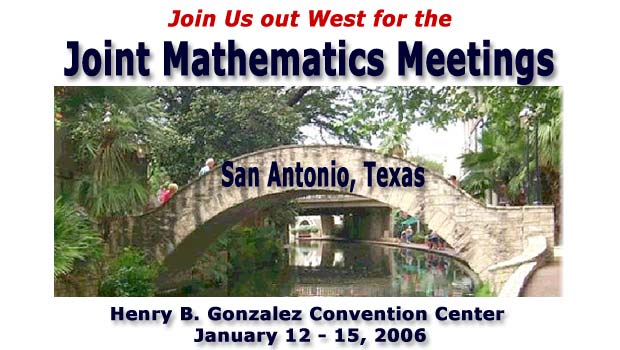
![]() CLICK
HERE TO SEARCH
THIS MEETING SITE ONLY.
CLICK
HERE TO SEARCH
THIS MEETING SITE ONLY.
|
SIGMAAs will be hosting a number of interesting activities, sessions, and guest lecturers. There are currently nine such focus groups offering members opportunities to interact not only at meetings but throughout the year via newsletters and email-based communications. For more information visit www.maa.org/SIGMAA/SIGMAA.html. SIGMAA Officers Meeting, Friday, 8:00 a.m. to 10:00 a.m., chaired by Stephen C. Carlson, Rose-Hulman Institute of Technology. SIGMAA on Business, Industry, and Government Reception, Friday, 5:45 p.m. to 6:45 p.m. (see the "Social Events" section). Mathematics Experiences in Business, Industry and Government, Saturday, 8:00 a.m. to 11:00 a.m. (see the "Contributed Paper Session" section). SIGMAA on Environmental Mathematics Environmental Modeling, Thursday, 2:15 p.m. to 4:15 p.m. (see the "Invited Paper Session" section). Business Meeting and Special Invited Presentation, Thursday, 4:15 p.m. to 6:15 p.m., organized by Ben A. Fusaro, Florida State University. Guest lecturer Bruce Herbert, TAMU Geology Department, will speak on Complex earth and environmental systems. The Environmental Math SIGMAA has organized a Saturday afternoon bus trip. It will be led by Texas A&M geologist Bruce Herbert. The focus of the trip is a slow-moving, massive underground river, the Edwards Aquifer. San Antonio and many Texas cities in the surrounding region are semi arid. They, like the 18th century Spanish missions, were able to thrive because of the large and abundant springs fed by this aquifer. It currently supplies the water for agricultural, industrial, recreational, and domestic needs of two million users. We will visit the San Marcos mission, about 45 minutes from San Antonio. There are more than 200 springs near San Marcos, most of which burst forth from three large fissures. Along the way, Dr. Herbert will give us a minicourse on the hydrology of the aquifer. We will stop occasionally to examine interesting geological features. We will depart at 1:30 pm and return at 5:00 pm. For just $15 you can join us in this trip led by a knowledgeable and enthusiastic educator and geologist. Send email to Michael Pearson, pearson@maa.org, or Hal Nesbitt, HNesbitt@maa.org, to reserve a seat. For more information contact Ben Fusaro, fusaro@math.fsu.edu. SIGMAA on the History of Mathematics Using History of Mathematics in Your Mathematics Courses, Friday, 8:00 a.m. to noon. (see the "Contributed Paper Session" section). Annual Meeting and Guest Lecture, Friday, 6:00 p.m. to 8:00 p.m., organized by Amy Shell-Gellasch, Grafenwoer, Germany. The annual business meeting will begin with light snacks and a cash bar. The annual invited lecture will follow the meeting. This year Kim L. Plofker, University of Utrecht, will speak on History of mathematics and original sources in India: A fieldwork report. For more information, please go to the HOM SIGMAA website, accessible from the MAA website, or contact Amy Shell-Gellasch at amy.shellgellasch@us.army.mil. The Shapes of Sacred Space: The Geometry of Ancient Maya Art and Architecture, organized by Amy Shell-Gellasch, Grafenwoer, Germany, Thursday, 9:30 a.m. to 10:50 a.m. Edwin L Barnhart, Director of Maya Exploration Center, and Christopher Powell, Senior Research Associate of Maya Exploration Center will discuss an exciting new line of research on what is being called “Maya Sacred Geometry”. Based on Powell’s own original research, it will explain how, like the ancient Egyptians and Greeks, the Maya used proportions derived from nature in their art and architecture. Decades of research have failed to produce a Maya “unit of measure” and now Powell’s research finally explains why. Buildings and stone carved panels exhibiting the Golden Proportion, as well as the dynamic proportions of square root rectangles, are now being "discovered" all over the ancient Maya World. Evidence for a still surviving tradition of Maya geometry will also be presented. This session is sponsored by the MAA SIGMAA on the History of Mathematics. SIGMAA on the Philosophy of Mathematics Annual Meeting, Reception, and Guest Lecture, Saturday, 6:00 p.m. to 8:00 p.m., organized by Bonnie Gold, Monmouth University. The meeting will be chaired by Roger A. Simons, Rhode Island College. The guest lecture will be given by Paul Humphreys, University of Virginia. SIGMAA on Quantitative Literacy Business Meeting and Reception, Saturday, 4:00 p.m. to 5:00 p.m., organized by Caren L. Diefenderfer, Hollins University; Judith F. Moran, Trinity College; and Maura B. Mast, University of Massachusetts Boston. SIGMAA on Research in Undergraduate Mathematics Research on the Teaching and Learning of Undergraduate Mathematics, Friday, 1:00 pm to 4:00 pm (see the "Contributed Paper Session" section). Business Meeting and Guest Lecturer, Friday, 5:45 p.m .to 7:45 p.m., organized by Barbara E. Edwards, Oregon State University. A MAA Notes Sampler, Sunday, 9:00 a.m. to 10:20 a.m., organized by Barbara E. Edwards, Oregon State University, and William O. Martin, North Dakota State University. The panel will discuss several chapters from an upcoming MAA Notes volume on research in undergraduate mathematics education, with emphasis on the implications of that research in the teaching of undergraduate mathematics courses. The volume will include papers written by mathematics education researchers and by mathematicians discussing topics in the undergraduate curriculum as well as overarching issues in undergraduate mathematics education. Panelists are Chris Rasmussen, San Diego State University; and Marilyn P. Carlson and Michael Oehrtman, Arizona State University. SIGMAA on Statistics First Steps for Implementing the Recommendations of the Guidelines for Assessment and Instruction in Statistics Education (GAISE) College Report, Saturday afternoon, 1:00 p.m. to 5:00 p.m. (see the "Contributed Paper Session" section). SIGMAA on Statistics Education Implications of the New ASA (GAISE) Guidelines for Teaching Statistics, Thursday, 8:00 a.m. to 9:20 a.m., organized by Thomas L. Moore, Grinnell College, and Christopher J. Lacke, Rowan University. Participants in the Guidelines for Assessment and Instruction in Statistics Education (GAISE) project have created two reports of recommendations for introductory statistics courses (college level) and statistics education in preKto12 years. These committees were commissioned by the American Statistical Association, which recently approved the recommendations of both GAISE committees. This panel will explore implications of the college-level GAISE recommendations to how we teach introductory statistics and implications of the preKto12 GAISE recommendations to how we prepare elementary, middle grade, and secondary teachers as well as implications for college statistics teachers on serving students who enter college having studied statistics. We will hear two panelists from each GAISE committee, one of whom will discuss the history and context of the committee's work and the other of whom will discuss the current state of their recommendations within their respective domains of college-level statistics and preKto12 level statistics. Panelists will be Robin H. Lock, St. Lawrence University; Roxy Peck, California Polytechnic State University, San Luis Obispo; Mike Perry, Appalachian State University; and Jessica Utts, University of California Davis. The session will be moderated by Carolyn K. Cuff, Westminster College. Requiring Statistics of Every Mathematics Major: Model Courses, Thursday, 9:30 a.m. to 10:50 a.m. (see "MAA Other Sessions" section). Business Meeting, Friday, 5:45 p.m. to 7:45 p.m., organized by Thomas L. Moore, Grinnell College. There will be refreshments, prizes, and a chance to network with statistics educators from around the country. SIGMAA on the Teaching of Advanced High School Mathematics AP Calculus: Friend or Foe?, Saturday, 9:00 a.m. to 10:20 a.m., organized by Daniel J. Teague, North Carolina School of Science and Mathematics. It is estimated that as many as 500,000 students are taking calculus in high school this year, the majority of them through an AP course. Does AP calculus serve the needs of these students for a strong foundation in mathematics or has the rush to calculus weakened the students' background in precalculus mathematics? Is AP calculus the best preparation for future mathematicians? How are we addressing the 200,000 students who have taken calculus in high school but are repeating the course in college because they either did poorly on the AP exam, or took calculus for college admissions with no expectation of advanced placement? What can the MAA community of mathematicians offer AP teachers to insure that AP calculus continues to be a friend to quality mathematics education rather than a foe? Panelists include David M. Bressoud, Macalaster College; Susan Schwartz Wildstrom, Walt Whitman High School; and Daniel Kennedy, The Baylor School. WEB SIGMAA Business Meeting and Guest Lectures, Friday, 6:00 p.m. to 7:30 p.m., organized by Murray Eisenberg, University of Massachusetts. The guest speakers are Thomas F. Banchoff, Brown University, and Douglas A. Quinney, University of Keele. Serious Data and Serious Tools on the Web for a Serious Problem, Saturday, 2:30 p.m. to 3:50 p.m., organized by Franklin A. Wattenberg, U.S. Military Academy. In 1972 the authors of Limits to Growth said, "If present growth trends in world population, industrialization, pollution, food production, and resource depletion continue unchanged, the limits to growth on this planet will be reached sometime within the next 100 years. The most probable result will be a rather sudden and uncontrolled decline in both population and industrial capacity." Julian Symon responded, "The material conditions of life will continue to get better for most people, in most countries, most of the time, indefinitely." Thirty-three years later the debate rages on. Besides being an important problem, this is an excellent venue for mathematical modeling. At the U.S. Military Academy this topic is a theme in the mathematics program from the first semester of the two-year core mathematics sequence through the senior-level capstone course. This session emphasizes model-building, and analyzing and using data obtained largely from the Web, rather than completed models. |
|
Book your airline ticket with Delta, the official airline of the meeting! |
